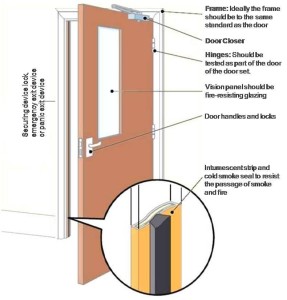
Fire-rated doors are excellent options when it comes to increasing the safety of your facility. Their purpose is pretty obvious – to keep fire and smoke from spreading throughout your facility. However, there are quite a few factors that come into play to guarantee that your door doesn’t lose its fire rating. Over time certain parts can lose their time as they withstand every day wear and tear. Here are a few tips that will help ensure your fire-rated door will pass inspection.
No Gaps
This one is the most obvious. The point of a fire-rated door is to not only keep fire from spreading but smoke as well. Any gaps between the wall and door are going to allow smoke to seep through, therefore endangering any occupants within the building. All holes and gaps need to be filled with fire-rated material.
Self-Latching
Over time, a latch can wear down causing it to slide in and out easier than intended. Your fire door must be completely self-latching in order to pass inspection. You may need to replace the latching device, just make sure it’s fire-labeled. It’s also important to remember that the existing mounting holes must be used and all holes must be filled. So, you can’t just slap a new latching device on the door wherever you want.
 Self-Closing
Self-Closing
The door needs to close on its own without any help from outside material or sources. Also, remember to keep the area around the door free of clutter and obstructions, and never prop the door open with anything other than the attached hardware (magnet, etc.)
Fire Labeled Hardware
Having a fire rated door alone isn’t enough to pass fire inspection. The door also must contain fire-labeled hardware as well. All the pieces throughout the entire door have to be considered fire-labeled. There can’t be any missing or broken parts and no field modifications that would void the door’s fire label are permitted.
Gaskets & Edge Seals
Edge seals and gaskets need to be intact, but they also must be the correct type of edge seal or gasket for the door. Not all seals and gaskets apply so a facility owner needs to be very aware of the different parts they’re using on the fire-rated door.
No paint
No parts on any of the fire-rated labels can be painted. A lot of times people aren’t actually aware that their door is fire-rated so, without thinking, they repaint the door, inadvertently covering the labels showing that the door’s fire rating. It’s something to be aware of because you don’t want a simple coat of paint to cause you to fail an inspection.
There are several posts on LockBytes discussing various aspects of fire-rated doors and the NFPA. It’s a very important topic and one that you can never know too much about.

Can a cat door be installed on a fire rated door? Any come with this feature?
I’m sorry, but no. The modifications you would have to make to the door to create a cat door would negate the rating.